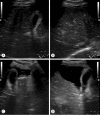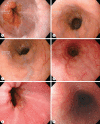Regression of esophageal varices during entecavir treatment in patients with hepatitis-B-virus-related liver cirrhosis
- PMID: 27044771
- PMCID: PMC4825159
- DOI: 10.3350/cmh.2016.22.1.183
Regression of esophageal varices during entecavir treatment in patients with hepatitis-B-virus-related liver cirrhosis
Abstract
Recent studies suggest that liver cirrhosis is reversible after administering oral nucleos(t)ide analogue therapy to patients with hepatitis B virus (HBV) infection. However, few studies have addressed whether esophageal varices can regress after such therapy. We report a case of complete regression of esophageal varices during entecavir therapy in patients with HBV-related liver cirrhosis, suggesting that complications of liver cirrhosis such as esophageal varices can regress after the long-term suppression of HBV replication.
Keywords: Entecavir; Esophageal varices; Hepatitis B virus; Liver cirrhosis.
Conflict of interest statement
Figures


Similar articles
-
Four-year entecavir therapy reduces hepatocellular carcinoma, cirrhotic events and mortality in chronic hepatitis B patients.Liver Int. 2016 Dec;36(12):1755-1764. doi: 10.1111/liv.13253. Epub 2016 Oct 4. Liver Int. 2016. PMID: 27634134
-
The long-term benefits of nucleos(t)ide analogs in compensated HBV cirrhotic patients with no or small esophageal varices: A 12-year prospective cohort study.J Hepatol. 2015 Nov;63(5):1118-25. doi: 10.1016/j.jhep.2015.06.006. Epub 2015 Jun 19. J Hepatol. 2015. PMID: 26100495
-
[Antiviral effects of entecavir in patients with hepatitis B virus-related cirrhosis].Zhonghua Gan Zang Bing Za Zhi. 2010 Feb;18(2):109-12. doi: 10.3760/cma.j.issn.1007-3418.2010.02.008. Zhonghua Gan Zang Bing Za Zhi. 2010. PMID: 20196949 Clinical Trial. Chinese.
-
An evaluation of entecavir for the treatment of chronic hepatitis B infection in adults.Expert Rev Gastroenterol Hepatol. 2016;10(2):177-86. doi: 10.1586/17474124.2016.1125781. Epub 2016 Jan 8. Expert Rev Gastroenterol Hepatol. 2016. PMID: 26610256 Review.
-
Entecavir in decompensated HBV cirrhosis: the future is looking brighter.J Hepatol. 2010 Feb;52(2):147-9. doi: 10.1016/j.jhep.2009.10.025. Epub 2009 Dec 16. J Hepatol. 2010. PMID: 20006400 Review. No abstract available.
Cited by
-
Antiviral therapy reduces rebleeding rate in patients with hepatitis B-related cirrhosis with acute variceal bleeding after endotherapy.BMC Gastroenterol. 2019 Jun 21;19(1):101. doi: 10.1186/s12876-019-1020-2. BMC Gastroenterol. 2019. PMID: 31226942 Free PMC article.
-
Pathophysiology and Management of Variceal Bleeding.Drugs. 2021 Apr;81(6):647-667. doi: 10.1007/s40265-021-01493-2. Epub 2021 Mar 12. Drugs. 2021. PMID: 33710585 Review.
-
Small Esophageal Varices in Patients with Cirrhosis-Should We Treat Them?Curr Hepatol Rep. 2018;17(4):301-315. doi: 10.1007/s11901-018-0420-z. Epub 2018 Nov 7. Curr Hepatol Rep. 2018. PMID: 30546995 Free PMC article. Review.
-
Dynamic monitoring with shear wave elastography predicts outcomes of chronic hepatitis B patients with decompensated cirrhosis.Ann Transl Med. 2021 Nov;9(21):1613. doi: 10.21037/atm-21-3142. Ann Transl Med. 2021. PMID: 34926657 Free PMC article.
References
-
- Lavanchy D. Hepatitis B virus epidemiology, disease burden, treatment, and current and emerging prevention and control measures. J Viral Hepat. 2004;11:97–107. - PubMed
-
- Korean Association for the Study of the Liver KASL Clinical Practice Guidelines: Management of chronic hepatitis B, update 2014. KASL Web site < http://www.kasl.org/bbs/?code=guide >. Accessed 2015.01.15. - PMC - PubMed
-
- European Association for the Study of the Liver EASL clinical practice guidelines: management of chronic hepatitis B virus infection. J Hepatol. 2012;57:167–185. - PubMed
-
- Lok AS, McMahon BJ. Chronic hepatitis B. Hepatology. 2007;45:507–539. - PubMed
-
- Liaw YF, Kao JH, Piratvisuth T, Chan HLY, Chin R, Liu C, et al. Asian-Pacific consensus statement on the management of chronic hepatitis B: a 2012 update. Hepatol Int. 2012;6:531–561. - PubMed
Publication types
MeSH terms
Substances
LinkOut - more resources
Full Text Sources
Other Literature Sources
Medical

